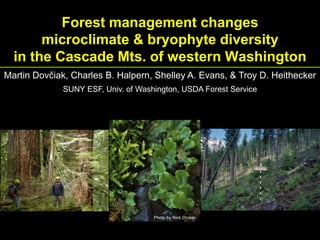
Forest management changes microclimate and bryophyte diversity in the Cascade Mountains of western Washington [Martin Dovciak]
- 1. Forest management changes microclimate & bryophyte diversity in the Cascade Mts. of western Washington Martin Dovčiak, Charles B. Halpern, Shelley A. Evans, & Troy D. Heithecker SUNY ESF, Univ. of Washington, USDA Forest Service Photo by Rick Droker
- 2. Global changes in land use Source: World Resources Institute / South Dakota State University, 2009 Intact Forest Landscapes Working Forest Landscapes Original forest cover Current
- 3. Land use changes threaten biodiversity Sala et al. (Science 287, 2000): Global Biodiversity Scenarios for the Year 2100
- 4. Biodiversity loss may affect ecosystem stability Tilman et al. (Nature 441, 2006) Dovčiak & Halpern (Ecol. Lett. 13, 2010) 0.9 Mean population stability Ecosystem stability (μ/σ) 0.6 0.3 5 10 15 Realized species number Mean Richness
- 5. Individual species important for ecosystem function M. Vieira www.stevesforums.com A. Syred
- 6. Significance of forest trees for bryophytes Forest canopy reduces solar radiation and thus affects microclimate temperature moisture Trees provide important microhabitats Decaying logs Tree trunks Forest Floor
- 7. Forest management in Pacific Northwest Policy: Northwest Forest Plan (NWFP) in 1994 No clear-cuts on federal lands At least 15% of canopy trees retained in harvested areas to mediate environmental changes due to harvest Science: DEMO Study in 1994 (Demonstration of Ecosystem Management Options) Examine effects of canopy removal on forest species Vascular plants Bryophytes Fungi Birds Small mammals Insects
- 8. Study hypotheses Bryophytes can be negatively affected by canopy removal (Dovčiak et al. Can. J. For. Res. 36, 2006) H-1. Bryophytes negatively affected on longer time scales richness, abundance, and liverwort proportion H-2. Bryophytes negatively affected in all microhabitats forest floor, decayed logs, and tree bases (NE vs. SW) H-3. Patterns of bryophyte decline are consistent with microclimatic changes caused by canopy removal
- 9. Study area – Cascade Mts., western Washington 3 sites mid-elevations (825-1280 m) mature forests (70-170 years) Douglas-fir dominated (Pseudotsuga menziesii) Mt. St. Helens Mt. Adams
- 10. Experimental design 3 sites (blocks) Treatment (retention level) 100% ( control) 40% 15% 3 treatments Tree bases Decaying logs (NE & SW) 4 microhabitats Forest floor Total of 576 quadrats (20 × 50 cm) 16 quadrats per microhabitat and treatment unit Sampled 8 years after canopy removal
- 11. Canopy structure after treatments Treatment (retention level) 100% (control) 40% 15%
- 12. Effects of canopy structure on microclimate PPFD (mols m-2 day-1) Basal area (m2ha-1) Air temp. max. (ºC) 80 35 a 40 b b c ab 60 30 30 b a 40 b 20 a 25 20 c a 10 20 c 0 0 100 40 15 0 100 40 15 0 100 40 15 0 Canopy retention (%) Canopy retention (%) Adapted from Heithecker & Halpern (For. Ecol. Manage. 226, 2006)
- 13. Richness of bryophytes Decaying logs Tree bases Forest floor No. of spp. per quadrat 6 6 6 a P < 0.0001 P < 0.0001 a b cn.s. 5 5 5 4 b 4 4 a 3 c 3 b 3 2 2 c 2 1 1 1 0 0 0 100 1 40 3 15 5 100 1 40 3 15 5 100 1 40 3 15 5 Canopy retention (%) Canopy retention (%) Canopy retention (%)
- 14. Abundance of bryophytes Decaying logs Tree bases Forest floor 50 a P < 0.0001 P < 0.0001 a b P <c 0.01 40 Cover (%) 30 a 20 b a ab b 10 b b c 0 100 1 40 3 15 5 100 1 40 3 15 5 100 1 40 3 15 5 Canopy retention (%) Canopy retention (%) Canopy retention (%)
- 15. Response of liverworts vs. mosses Liverworts Mosses Less resilient to More resilient to drought & heat stress drought & heat stress Scapania bolanderi Hylocomium splendens
- 16. Proportion of liverworts in bryophyte community Decaying logs Tree bases Forest floor Liverworts (%) 30 P < 0.001 n.s. n.s. 20 a 10 b b 0 100 1 40 3 15 5 100 1 40 3 15 5 100 1 40 3 15 5 Canopy retention (%) Canopy retention (%) Canopy retention (%)
- 17. Aspect effects on tree bases on richness Northeast Southwest No. of spp. per quadrat No. of spp. per quadrat 6 6 P < 0.02 P < 0.0001 5 5 4 4 a a a 3 b 3 2 2 b 1 1 c 0 0 100 1 40 3 15 5 100 1 40 3 15 5 Canopy retention (%) Canopy retention (%) Richness difference Diff. in no. of spp. 4 (NE minus SW) P < 0.0001 3 b b 2 1 a 0 100 1 40 3 15 5 Canopy retention (%)
- 18. Hypotheses revisited H-1. Bryophytes negatively affected over longer time scales Yes: even after 8 years after logging H-2. Bryophytes negatively affected in all microhabitats Yes: decayed logs > tree trunks > forest floor Yes: SW > NE side of tree trunks H-3. Patterns of bryophyte decline are consistent with microclimatic changes caused by canopy removal Yes: for differences among treatments Yes: for differences among aspects of tree trunks
- 19. Conclusions & implications Canopy retention under 40% does not preserve overall bryophyte diversity and abundance Current management prescription to retain ≥ 15% of canopy is not sufficient Global climate change (warming, droughts) is likely to exacerbate the effects of timber harvest Photos by Rick Droker
- 20. Acknowledgements Funding: USDA Forest Service and PNW Research Station DEMO research partners: USDA Forest Service Region 6 Pacific Northwest Research Station University of Washington Oregon State University University of Oregon Gifford Pinchot and Umpqua N.F. Washington DNR Rick Droker Web site: http://www.fs.fed.us/pnw/rmp/demo/
